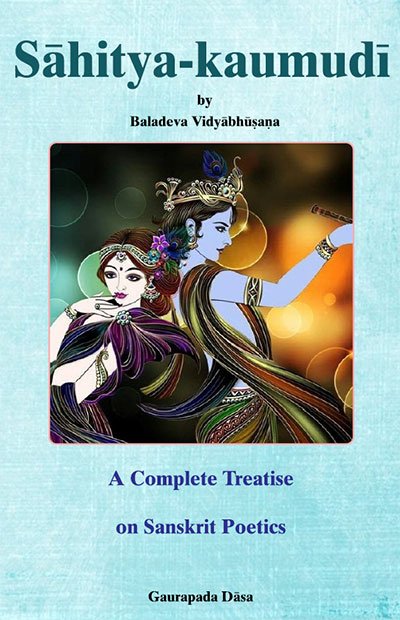Sahitya-kaumudi by Baladeva Vidyabhushana
by Gaurapada Dāsa | 2015 | 234,703 words
Baladeva Vidyabhusana’s Sahitya-kaumudi covers all aspects of poetical theory except the topic of dramaturgy. All the definitions of poetical concepts are taken from Mammata’s Kavya-prakasha, the most authoritative work on Sanskrit poetical rhetoric. Baladeva Vidyabhushana added the eleventh chapter, where he expounds additional ornaments from Visv...
Text 4.62
अथ द्वितीयम् आह,
atha dvitīyam āha,
Now he subdivides the second one (artha-śakti-bhū dhvani):
artha-śakty-udbhavo’py artho vyañjakaḥ sambhavī svataḥ ||4.39cd||
prauḍhokti-mātrāt siddho vā kaves tenombhitasya vā |
vastu vālaṅkṛtir veti ṣaḍ-bhedo’sau vyanakti yat ||4.40||
vastv alaṅkāram atha vā tenāyaṃ dvādaśātmakaḥ ||4.41ab||
artha-śakty-udbhavaḥ—arisen from the force of the meaning [of a word]; api—also (i.e. that kind of meaning as well is suggestive); arthaḥ—a meaning; vyañjakaḥ—suggestive; sambhavī—it arises (or possible); svataḥ—automatically; prauḍha-ukti-mātrāt—only from a bold statement; siddhaḥ—accomplished (effected); vā—or; kaveḥ—of the poet; tena—by him (the poet); umbhitasya—[effected merely from a bold statement of a speaker] who is filled (i.e. invented[1]); vā—or; vastu—an idea; vā—or; alaṅkṛtiḥ—a literary ornament; vā—or; iti—in this way; ṣaḍ-bhedaḥ—sixfold; asau—it (the meaning); vyanakti—suggests; yat—because; vastu—an idea; alaṅkāram—a literary ornament; atha—afterward; vā—or; tena—therefore; ayam—this (the meaning); dvādaśa-ātmakaḥ—consists of twelve.
The meaning (literal or implied) that arises by the force of a meaning (artha-śakti) is suggestive. Initially it is of three kinds: (1) svataḥ-sambhavī (it is naturally possible), (2) kavi-prauḍhokti-siddha (it is effected from a bold assertion made by the poet), and (3) kavi-kalpita-vaktṛ-prauḍhokti-siddha (it is effected from a bold assertion of a speaker invented by the poet). Next it has six subvarieties because it is either a vastu or an alaṅkāra. Afterward, one of those two suggests either a vastu or an alaṅkāra, therefore an implied sense arisen by artha-śakti occurs in one of twelve ways.
artho’pi artha-śakty-udbhave dhvanau vyañjakaḥ. sa ca svataḥ-sambhavī loke’pi dṛṣṭaḥ. tasminn adṛṣṭo’pi kaveḥ pratibhāmātreṇa siddhaḥ. tena kavinā pūritasya[2] vaktur nāyakāder veti trividho’sau pratyekaṃ vastutvālaṅkṛtitvābhyāṃ dvaividhyāt ṣaḍ-bhedaḥ sann ekaiko vastv-alaṅkārau vyanaktīti tasya dvādaśa-vidho vyaṅgyaḥ, tena hetunāyam artha-śakty-udbhavo dhvanir api dvādaśa-vidhaḥ.
Even the meaning (usually an implied meaning)[3] is suggestive, when a dhvani arises by the force of that meaning. The one which is svataḥ-sambhavī (it is naturally possible) is seen even in day-to-day life. Although unseen in day-to-day life, the second one is effected merely by the poet’s creative intelligence. Or else it is effected by the wit of a speaker, such as a lover, who is invented by the poet. Those are three categories. Next the total is six categories, since each one is twofold, by being either a vastu or an alaṅkāra. Afterward, one of the two (a vastu or an alaṅkāra) suggests either a vastu or an alaṅkāra, therefore twelve kinds of it are implied. Consequently the dhvani which arises by the force of a meaning (artha-śakti-bhū) has twelve varieties.
Commentary:
In all three broad categories, the poet’s creativity is central. In the first category, however, the suggestive idea or the suggestive ornament could occur in day-to-day life.[4]
The twelve kinds are as follows. The upcoming examples are shown by this sequence:
✡ a svataḥ-sambhavī vastu-dhvani (or vastu) gives rise to another vastu-dhvani,
✡ a svataḥ-sambhavī vastu-dhvani (or vastu) gives rise to an alaṅkāra-dhvani,
✡ a svataḥ-sambhavī alaṅkāra-dhvani (or alaṅkāra) gives rise to a vastu-dhvani,
✡ a svataḥ-sambhavī alaṅkāra-dhvani (or alaṅkāra) gives rise to an alaṅkāra-dhvani,
✡ a kavi-prauḍhokti-siddha vastu-dhvani (or vastu) gives rise to another vastu-dhvani,
✡ a kavi-prauḍhokti-siddha vastu-dhvani (or vastu) gives rise to an alaṅkāra-dhvani,
✡ a kavi-prauḍhokti-siddha alaṅkāra-dhvani (or alaṅkāra) gives rise to a vastu-dhvani,
✡ a kavi-prauḍhokti-siddha alaṅkāra-dhvani (or alaṅkāra) gives rise to an alaṅkāra-dhvani,
✡ a kavi-kalpita-vaktṛ-prauḍhokti-siddha vastu-dhvani (or vastu) gives rise to another vastu-dhvani,
✡ a kavi-kalpita-vaktṛ-prauḍhokti-siddha vastu-dhvani (or vastu) gives rise to an alaṅkāra-dhvani,
✡ a kavi-kalpita-vaktṛ-prauḍhokti-siddha alaṅkāra-dhvani (or alaṅkāra) gives rise to a vastu-dhvani,
✡ a kavi-kalpita-vaktṛ-prauḍhokti-siddha alaṅkāra-dhvani (or alaṅkāra) gives rise to an alaṅkāra-dhvani.
Abhinavagupta says that the four prototypical categories of artha-śakti—a vastu gives rise to a vastu; a vastu gives rise to an alaṅkāra; an alaṅkāra gives rise to a vastu; and an alaṅkāra gives rise to an alaṅkāra—also apply to the category of śabda-śakti.[5]
Footnotes and references:
[1]:
[2]:
However, in the elaborationof text 4.74 Baladeva Vidyābhūṣaṇa uses the term kalpita (invented) in this context. Kavikarṇapūra prefers the term nibaddha (literarily constructed).
[3]:
In Kavikarṇapūra’s methodology, the meaning referred to here is always an implied meaning (an implied vastu or an implied alaṅkāra): artha-śakty-udbhavo yo dhvaniḥ, sa tridhā bhavati—svataḥ-sambhavī, kavi-prauḍhokti-niṣpanna-śarīraḥ, tan-nibaddha-vaktṛ-prauḍhokti-niṣpannaśarīraś ceti (Alaṅkāra-kaustubha 3.15). However, in Mammaṭa and Baladeva Vidyābhūṣaṇa’s system, that is not always the case.
[4]:
[5]:
evam iti, avivakṣita-vācyo vivakṣitānya-para-vācya iti dvau mūla-bhedau. ādyasya dvau bhedau, atyanta-tiraskṛta-vācyo’rthāntara-saṅkramita-vācyaś ca. dvitīyasya dvau bhedau, alakṣya-kramo’nuraṇana-rūpaś ca. prathamo’nanta-bhedaḥ. dvitīyo dvividhaḥ, śabda-śaktimūlo’rtha-śakti-mūlaś ca. paścimas trividhaḥ, kavi-prauḍhokti-kṛta-śarīraḥ kavi-nibaddhavaktṛ-prauḍhokti-kṛta-śarīraḥ svatas-sambhavī ca. te ca pratyekaṃ vyaṅgya-vyañjakayor ukta-bheda-nayena caturdheti dvādaśa-vidho’rtha-śakti-mūlaḥ. ādyaś catvāro bhedā iti ṣodaśa mukhya-bhedāḥ (Locana 2.31).
